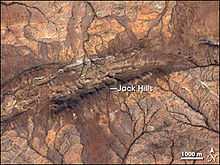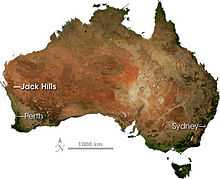Jack Hills


The Jack Hills are a range of hills in Mid West Western Australia. They are best known as the source of the oldest material of terrestrial origin found to date: zircons that formed around 4.4 billion years ago. These zircons have enabled ground-breaking research into the conditions on earth in the Hadean eon.
Geography
They are located on the border of the Shire of Murchison and the Shire of Meekatharra, south of the Murchison River, about 800 kilometres (500 mi) north of Perth.
Geology
The Jack Hills are located in the Narryer Gneiss Terrane of the Yilgarn Craton, Western Australia, and comprise an 80 kilometres (50 mi) long northeast-trending belt of folded and metamorphosed supracrustal rocks.[1]
Sedimentary siliciclastic rocks, interpreted as alluvial fan-delta deposits, are the major lithology. Minor mafic/ultramafic rocks and banded iron formation (BIF) are also found in the sequence. The overall sequence is generally considered to be a granulite gneiss, which has undergone multiple deformations and multiple metamorphic episodes. The protolith age of the Narryer Gneiss Terrane is variable, but generally considered to be in excess of 3.6 Ga (billion years).
Oldest zircons on earth
Detrital zircons with ages greater than 4 billion years old have been found in these rocks, and a 4,404 +/-8 million year old zircon was found at Erawandoo Hill;[2] this is the oldest dated material originating on Earth; the date is in the Cryptic era of the Hadean eon. They were found within a unit of the supracrustal sequence, a metamorphosed conglomerate considered to have an age ~3.0 Ga. Given the detrital nature of the rock unit, the zircons are sourced from pre-existing rocks which were then weathered and the resultant sediment deposited as sedimentary rock.[3]
The zircons and various aspects of their geochemistry provide evidence for the existence of continental-type crust on the surface of the earth during the Hadean eon, contrasting with earlier ideas on the earliest phase of Earth's history. Additionally, oxygen isotopic ratios in the zircons provide evidence for the presence of liquid water on the surface, if not a water ocean;[4] also contrasting with earlier ideas on Earth's history. The theory of humid and cool conditions before the Late Heavy Bombardment has been promoted as Cool Early Earth.
Economic geology
The Jack Hills banded iron formation is the site of a minor iron ore mine operated by Crosslands Resources (a 50:50 venture between Murchison Mines and Mitsubushi Development) which is exporting 3 million tonnes per annum of high grade detrital hematite iron ore via the port of Geraldton. The company plans to expand the operation to include extraction of the magnetite bearing BIF.
Other companies operating in the area are also planning major magnetite BIF based iron ore mines.[5]
Conservation
Because of their importance as a geology research site, the Jack Hills were nominated to the Register of the National Estate in 2003. As of 2009, they have an "Interim Listing", which means they have been formally proposed for inclusion in the Register.[6]
References
- ↑ "Western Australia's Jack Hills". NASA Earth Observatory newsroom. Retrieved 2006-04-28.
- ↑ Wilde, S. A.; et al. (2001). "Evidence from detrital zircons for the existence of continental crust and oceans on the Earth 4.4 Gyr ago." (PDF). Nature 409 (6817): 175–178. doi:10.1038/35051550. PMID 11196637.
- ↑ Zircons are Forever "Zircons are Forever". Retrieved 2007-04-28.
- ↑ Lindsey, Rebecca (1 March 2006). "Ancient Crystals Suggest Earlier Ocean". NASA Earth Observatory. Retrieved 2006-04-28.
- ↑ "Midwest Resources Conference 2007" (PDF). Midwest Development Corporation. 1 March 2007. Archived from the original on 2007-08-30. Retrieved 2007-08-31.
- ↑ "Jack Hills, Cue, WA, Australia (entry AHD18283)". Australian Heritage Database. Department of Sustainability, Environment, Water, Population and Communities. Retrieved 2009-02-01.